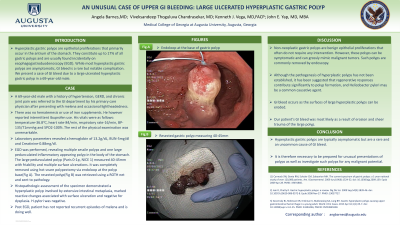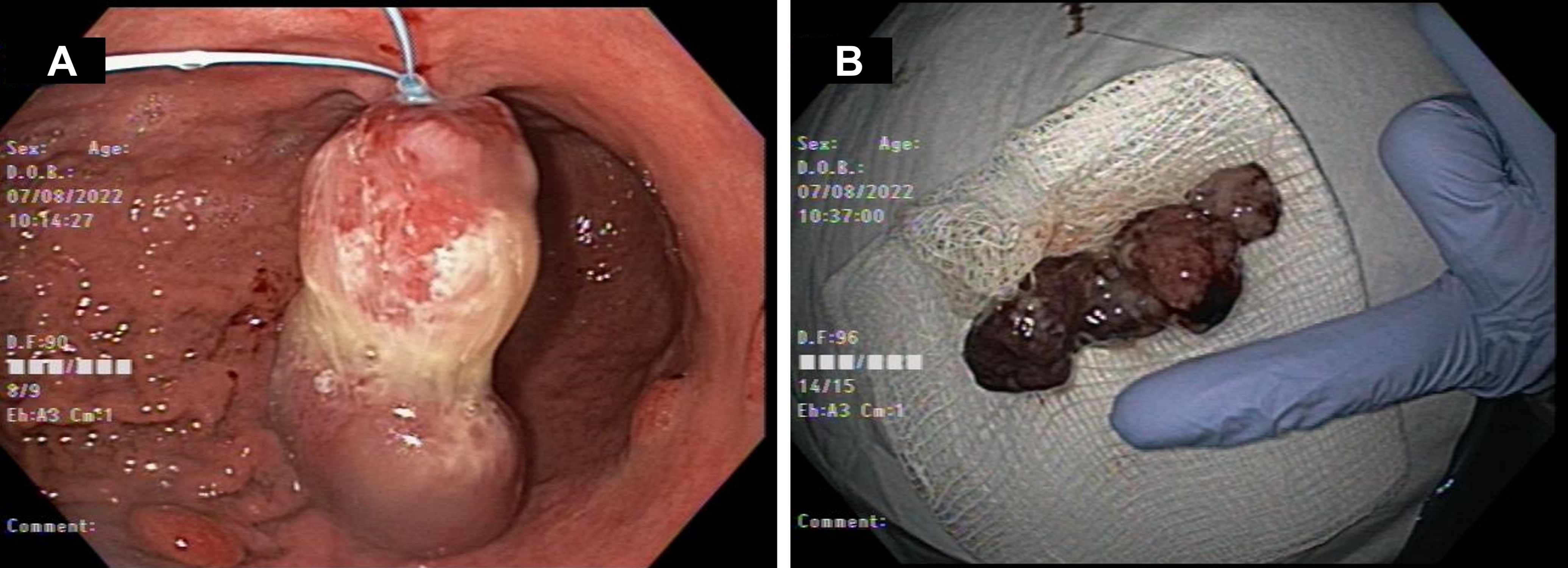Tuesday Poster Session
Category: GI Bleeding
P3521 - An Unusual Case of Upper GI Bleeding: Large Ulcerated Hyperplastic Gastric Polyp
Tuesday, October 24, 2023
10:30 AM - 4:00 PM PT
Location: Exhibit Hall

Has Audio
- AB
Angela Barnes, MD
Medical College of Georgia at Augusta University
Augusta, GA
Presenting Author(s)
Angela Barnes, MD, Viveksandeep Thoguluva Chandrasekar, MD, Kenneth J. Vega, MD, FACG, John Erikson Yap, MD, MBA
Medical College of Georgia at Augusta University, Augusta, GA
Introduction: Hyperplastic gastric polyps are epithelial proliferations that primarily occur in the antrum of the stomach. They constitute up to 17% of all gastric polyps and are usually found incidentally on esophagogastroduodenoscopy (EGD). While most hyperplastic gastric polyps are asymptomatic, GI bleed is a rare but notable complication. We present a case of GI bleed due to a large ulcerated hyperplastic gastric polyp.
Case Description/Methods: A 69-year-old male with a history of GERD was referred to the GI department after presenting with recurrent episodes of melena. There was no hematemesis or use of iron supplements. He however reported intermittent Ibuprofen use. His vitals were stable and the rest of the physical examination was unremarkable. Laboratory parameters revealed a hemoglobin of 13.2g/dL, BUN-5mg/dl and Creatinine-0.88mg/dl. EGD was performed, revealing multiple sessile polyps and one large pedunculated inflammatory appearing polyp in the body of the stomach. The large pedunculated polyp (Paris 0-1p, NICE 1) measured 40-45mm with friability and multiple surface ulcerations. It was completely removed using hot snare polypectomy via endoloop at the polyp base (Fig A). The resected polyp (Fig B) was retrieved using a ROTH net and sent to pathology. Histopathologic assessment of the specimen demonstrated a hyperplastic polyp involved by extensive intestinal metaplasia, marked reactive changes associated with surface ulceration and negative for dysplasia. H.pylori was negative. Post EGD, our patient has not reported any episodes of melena and is doing well.
Discussion: Non-neoplastic gastric polyps are benign epithelial proliferations that often do not require any intervention. However, these polyps can be symptomatic and can grossly mimic malignant tumors. Such polyps are commonly removed by endoscopy. Although the pathogenesis of hyperplastic polyps has not been established, it has been suggested that regenerative responses contribute significantly to polyp formation, and Helicobacter pylori may be a common causative agent. GI bleed occurs as the surfaces of large hyperplastic polyps can be eroded. Our patient’s GI bleed was most likely as a result of erosion and sheer trauma of the large polyp. Hyperplastic gastric polyps are typically asymptomatic but are a rare and an uncommon cause of GI bleed. It is therefore necessary to be prepared for unusual presentations of polyps as well as investigate such polyps for any malignant potential.

Disclosures:
Angela Barnes, MD, Viveksandeep Thoguluva Chandrasekar, MD, Kenneth J. Vega, MD, FACG, John Erikson Yap, MD, MBA. P3521 - An Unusual Case of Upper GI Bleeding: Large Ulcerated Hyperplastic Gastric Polyp, ACG 2023 Annual Scientific Meeting Abstracts. Vancouver, BC, Canada: American College of Gastroenterology.
Medical College of Georgia at Augusta University, Augusta, GA
Introduction: Hyperplastic gastric polyps are epithelial proliferations that primarily occur in the antrum of the stomach. They constitute up to 17% of all gastric polyps and are usually found incidentally on esophagogastroduodenoscopy (EGD). While most hyperplastic gastric polyps are asymptomatic, GI bleed is a rare but notable complication. We present a case of GI bleed due to a large ulcerated hyperplastic gastric polyp.
Case Description/Methods: A 69-year-old male with a history of GERD was referred to the GI department after presenting with recurrent episodes of melena. There was no hematemesis or use of iron supplements. He however reported intermittent Ibuprofen use. His vitals were stable and the rest of the physical examination was unremarkable. Laboratory parameters revealed a hemoglobin of 13.2g/dL, BUN-5mg/dl and Creatinine-0.88mg/dl. EGD was performed, revealing multiple sessile polyps and one large pedunculated inflammatory appearing polyp in the body of the stomach. The large pedunculated polyp (Paris 0-1p, NICE 1) measured 40-45mm with friability and multiple surface ulcerations. It was completely removed using hot snare polypectomy via endoloop at the polyp base (Fig A). The resected polyp (Fig B) was retrieved using a ROTH net and sent to pathology. Histopathologic assessment of the specimen demonstrated a hyperplastic polyp involved by extensive intestinal metaplasia, marked reactive changes associated with surface ulceration and negative for dysplasia. H.pylori was negative. Post EGD, our patient has not reported any episodes of melena and is doing well.
Discussion: Non-neoplastic gastric polyps are benign epithelial proliferations that often do not require any intervention. However, these polyps can be symptomatic and can grossly mimic malignant tumors. Such polyps are commonly removed by endoscopy. Although the pathogenesis of hyperplastic polyps has not been established, it has been suggested that regenerative responses contribute significantly to polyp formation, and Helicobacter pylori may be a common causative agent. GI bleed occurs as the surfaces of large hyperplastic polyps can be eroded. Our patient’s GI bleed was most likely as a result of erosion and sheer trauma of the large polyp. Hyperplastic gastric polyps are typically asymptomatic but are a rare and an uncommon cause of GI bleed. It is therefore necessary to be prepared for unusual presentations of polyps as well as investigate such polyps for any malignant potential.

Figure: A - Endoloop at the base of gastric polyp.
B - Resected gastric polyp measuring 40-45mm
B - Resected gastric polyp measuring 40-45mm
Disclosures:
Angela Barnes indicated no relevant financial relationships.
Viveksandeep Thoguluva Chandrasekar indicated no relevant financial relationships.
Kenneth Vega indicated no relevant financial relationships.
John Erikson Yap indicated no relevant financial relationships.
Angela Barnes, MD, Viveksandeep Thoguluva Chandrasekar, MD, Kenneth J. Vega, MD, FACG, John Erikson Yap, MD, MBA. P3521 - An Unusual Case of Upper GI Bleeding: Large Ulcerated Hyperplastic Gastric Polyp, ACG 2023 Annual Scientific Meeting Abstracts. Vancouver, BC, Canada: American College of Gastroenterology.

